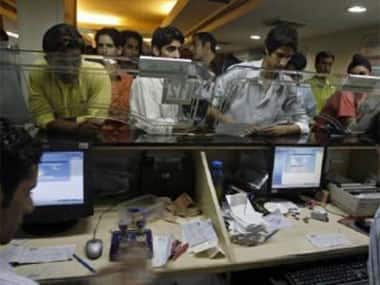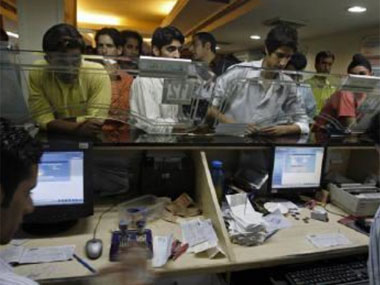There’s no surprise here. The number of bank accounts opened under the Prime Minister’s Jan Dhan Yojana (PMJDY), Narendra Modi’s ambitious financial inclusion programme, has breezed past the government’s target much ahead of time. According to the
data available on the PMJDY website
, banks have opened as many as 10.09 crore accounts accounts as of 26 December. Of this, 8.03 crore accounts have been open by public sector banks, 1.8 crore by regional rural banks and a minuscule 27.13 lakh by private sector banks. The total balance in the accounts stand at Rs 7,778.42 crore. And of the total accounts, nearly 75 percent, or 7.41 crore, have no balance. That the government-set target will be met and also surpassed well before the deadline was a foregone conclusion given the fever pitch with which the banks were opening accounts as they were under immense pressure from the government to make the programme a success. [caption id=“attachment_2020293” align=“alignleft” width=“380”]
 Reuters[/caption] While launching the scheme the prime minister had set a target of 7.5 crore accounts by 26 January. In order to make the account opening easy, some of the norms were also relaxed.
The Reserve Bank of India had given a six-month leeway
for low-risk customers to submit their KYC documents to open the accounts. As the banks stepped up opening of the accounts, the government also raised the bar by increasing the target to 10 crore accounts by 26 January. In fact,
the government is eyeing an entry in the Guinness World Records
for opening maximum number of bank accounts in the least time. As Firstbiz
had earlier reported
, “bankers were put at gun point to meet the targets, in turn, forcing them to offer accounts to everyone on the street, who meet or do not meet minimum KYC requirements”. Many bankers, on the condition of anonymity, had even expressed their apprehensions about the scheme as, in their desperate bid to meet the target, they were conveniently forgetting the know your customer norms. The finance ministry, meanwhile, has highlighted PMJDY as one of its biggest achievements in the past six months. According to a PTI report, the other achievements listed by the ministry include Varishtha Pension Bima Yojana (VPBY) and actions taken to curb black money. “As on December 1, states of Goa, Kerala, Tripura and Madhya Pradesh, Union Territories of Chandigarh, Puducherry and Lakshadweep have achieved 100 per cent Saturation (all households with at least one bank account),” the report said citing a press release. While financial inclusion is a much needed policy initiative to weed out poverty and bring the unbanked under formal banking, what is raising concern is the pressure being put on the banks. Moreover, as is visible in the above statistics, there is an unfair burden on public sector banks which is likely to affect their profitability and also result in rampant misuse of such accounts by hawala operators. Such fears apart, one good thing about the scheme would be that these accounts will be helpful in successfully rolling out the direct benefit transfer (DBT) of cash subsidies. The government started DBT for LPG on 15 November in 54 districts. From 1 January, it will be launched all over the country. Eventually, the plan is to bring all subsidy schemes, including food subsidy and NREGA, under DBT. That would mean all the Jan Dhan accounts will see cash transfers, making all of them operational and
helping banks break even these accounts
. Until such time, however, banks will have to bear the burden.
Reuters[/caption] While launching the scheme the prime minister had set a target of 7.5 crore accounts by 26 January. In order to make the account opening easy, some of the norms were also relaxed.
The Reserve Bank of India had given a six-month leeway
for low-risk customers to submit their KYC documents to open the accounts. As the banks stepped up opening of the accounts, the government also raised the bar by increasing the target to 10 crore accounts by 26 January. In fact,
the government is eyeing an entry in the Guinness World Records
for opening maximum number of bank accounts in the least time. As Firstbiz
had earlier reported
, “bankers were put at gun point to meet the targets, in turn, forcing them to offer accounts to everyone on the street, who meet or do not meet minimum KYC requirements”. Many bankers, on the condition of anonymity, had even expressed their apprehensions about the scheme as, in their desperate bid to meet the target, they were conveniently forgetting the know your customer norms. The finance ministry, meanwhile, has highlighted PMJDY as one of its biggest achievements in the past six months. According to a PTI report, the other achievements listed by the ministry include Varishtha Pension Bima Yojana (VPBY) and actions taken to curb black money. “As on December 1, states of Goa, Kerala, Tripura and Madhya Pradesh, Union Territories of Chandigarh, Puducherry and Lakshadweep have achieved 100 per cent Saturation (all households with at least one bank account),” the report said citing a press release. While financial inclusion is a much needed policy initiative to weed out poverty and bring the unbanked under formal banking, what is raising concern is the pressure being put on the banks. Moreover, as is visible in the above statistics, there is an unfair burden on public sector banks which is likely to affect their profitability and also result in rampant misuse of such accounts by hawala operators. Such fears apart, one good thing about the scheme would be that these accounts will be helpful in successfully rolling out the direct benefit transfer (DBT) of cash subsidies. The government started DBT for LPG on 15 November in 54 districts. From 1 January, it will be launched all over the country. Eventually, the plan is to bring all subsidy schemes, including food subsidy and NREGA, under DBT. That would mean all the Jan Dhan accounts will see cash transfers, making all of them operational and
helping banks break even these accounts
. Until such time, however, banks will have to bear the burden.
Banks reach target of 10 cr Jan Dhan Yojana accounts, but nearly 75% have no money in them
FP Editors
• December 30, 2014, 08:19:27 IST
The government has listed PMJDY as an achievement of the finance ministry in the last six months
Advertisement
)
End of Article